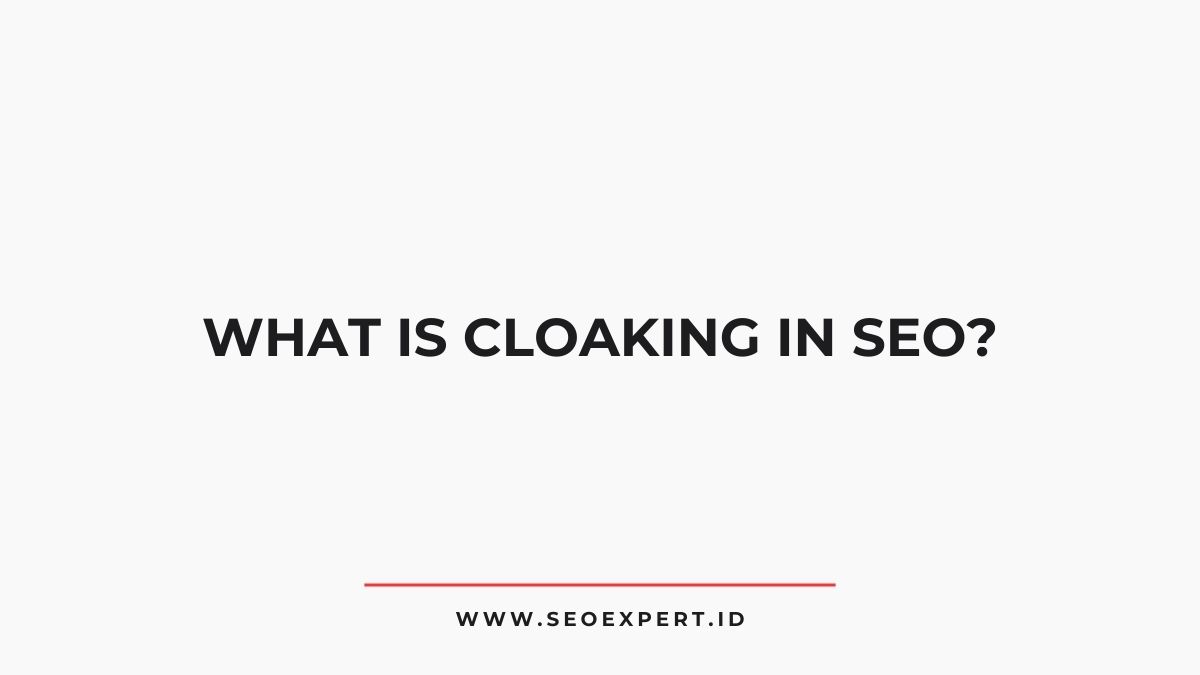Cloaking in SEO is a controversial technique where different content is shown to search engines and users.
LinkWhisper
The ultimate internal linking plugin for WordPress that can elevate your on-page SEO. Recognized as the finest in the field. Simple to install with powerful features.
This practice aims to artificially manipulate search engine rankings by delivering optimized content to crawlers while presenting varied information to visitors.
It often involves methods like IP delivery and user-agent detection. However, using cloaking can lead to severe penalties from search engines, loss of credibility, and legal repercussions.
Understanding its implications and ethical alternatives is essential for effective digital marketing strategies.
TL;DR
Hide- Cloaking is an SEO technique that presents different content to users and search engines to manipulate rankings.
- It often involves methods like user-agent detection and IP delivery to show tailored content.
- Search engines like Google penalize websites that use cloaking, leading to ranking drops or de-indexing.
- Cloaking undermines user trust and can result in legal issues for misleading content.
- Ethical SEO practices focus on quality content and transparency, promoting long-term success without deceptive tactics.
Understanding Cloaking: Definition and Overview
Cloaking, a controversial technique in the domain of search engine optimization (SEO), refers to the practice of presenting different content or URLs to users and search engines.
This strategy is often employed to manipulate search engine rankings by displaying optimized content to crawlers while showing less relevant information to visitors.
Such practices can lead to significant ethical dilemmas, as they undermine the transparency expected in digital marketing.
Search engines, particularly Google, actively penalize websites that engage in cloaking, considering it a violation of their guidelines.
To maintain a safe online presence, businesses should prioritize ethical SEO strategies that enhance user experience rather than risk penalties associated with deceptive practices.
Understanding the implications of cloaking is essential for sustainable online success.
How Cloaking Works in SEO
Cloaking in SEO refers to the practice of presenting different content to users and search engines, often to manipulate search rankings.
Various techniques, such as user-agent detection and IP delivery, are employed to achieve this deceptive strategy.
However, the associated risks and consequences, including penalties from search engines, can considerably outweigh any short-term gains.
Definition of Cloaking
In the domain of search engine optimization (SEO), cloaking serves as a controversial technique that involves presenting different content to users and search engines.
This practice can manifest in various ways, such as delivering distinct HTML markup or employing user-agent detection to differentiate between human visitors and crawlers.
The primary objective of cloaking is often to manipulate search engine rankings by providing optimized content to search engines while delivering less relevant or misleading material to users.
Such strategies can pose significant risks, as search engines like Google actively penalize websites engaged in cloaking.
As a result, understanding the implications and ethical considerations of this technique is essential for webmasters seeking to maintain compliance and guarantee the longevity of their online presence.
Techniques Used in Cloaking
While various strategies can be employed to achieve cloaking in SEO, the most common techniques revolve around user-agent detection and IP delivery.
User-agent detection involves identifying the browser or device a visitor uses, allowing the website to serve different content accordingly. This technique guarantees that search engine crawlers receive optimized content, while regular users see a more tailored experience.
Conversely, IP delivery targets specific IP addresses to deliver distinct content, often used to redirect users based on geographic location.
Both methods can enhance user experience and improve search engine rankings; however, they require careful implementation to maintain compliance with search engine guidelines and uphold ethical standards in digital marketing.
Risks and Consequences
The use of cloaking techniques in SEO, such as user-agent detection and IP delivery, comes with significant risks and consequences that can jeopardize a website’s visibility and reputation.
Engaging in cloaking can lead to severe penalties from search engines, which prioritize transparency and user experience. The following risks should be carefully considered:
- Search Engine Penalties: Websites employing cloaking may face de-indexing or ranking drops.
- Loss of Credibility: Users may distrust sites that employ deceptive practices, harming brand reputation.
- Legal Ramifications: In some jurisdictions, misleading users can result in legal consequences.
- Inconsistent User Experience: Cloaking can lead to mismatched content, frustrating users and increasing bounce rates.
Website owners must weigh these factors against potential short-term gains.
Types of Cloaking Techniques
Cloaking techniques in SEO can be categorized into several distinct types, each serving specific purposes and employing various methods to manipulate search engine results.
One common technique is IP-based cloaking, where different content is shown to users based on their IP addresses.
Another method is user-agent cloaking, which delivers varied content based on the browser or device type.
JavaScript cloaking also exists, utilizing scripts to present different information to search engines compared to human visitors.
Additionally, there is content-based cloaking, where distinct content is created solely for search engines, often rich in keywords.
Each technique aims to enhance visibility and ranking; however, they can pose ethical and compliance challenges, warranting careful consideration before implementation.
The Risks of Using Cloaking
Although some may view cloaking as a shortcut to improving search engine rankings, the associated risks can considerably outweigh any potential benefits. Engaging in cloaking practices exposes websites to significant dangers that can jeopardize both their reputation and visibility.
- Search Engine Penalties: Websites caught using cloaking may face severe penalties, including removal from search engine indexes.
- Loss of Trust: Users may feel deceived, leading to a loss of credibility and trust in the brand.
- Inconsistent User Experience: Providing different content to users and search engines can create confusion, diminishing overall user satisfaction.
- Long-Term Viability: Relying on deceptive tactics can hinder sustainable growth, as search engines evolve to detect and penalize such practices.
Strategic adherence to ethical SEO practices is essential for long-term success.
Search Engine Guidelines on Cloaking
While many webmasters may be tempted to employ cloaking techniques to manipulate search engine results, search engine guidelines explicitly prohibit such practices.
Major search engines, including Google and Bing, emphasize transparency and relevance in their ranking criteria. Cloaking is defined as presenting different content to users than what is shown to search engines, creating a deceptive user experience.
Violating these guidelines can lead to severe penalties, including de-indexing from search results. Consequently, webmasters are encouraged to adhere strictly to ethical SEO practices that promote content alignment for both users and search engines.
Identifying Cloaking Practices on Your Website
Detecting cloaking practices on a website requires a systematic approach to examine how content is presented to both users and search engines.
Identifying these practices is vital for maintaining ethical standards and guaranteeing compliance with search engine guidelines.
- Content Variation: Review whether the content served to users differs markedly from what search engines index.
- User-Agent Testing: Utilize tools that simulate different user-agents to see if the content varies based on the requesting source.
- JavaScript Inspection: Analyze any JavaScript-driven content that might be hidden from search engines but visible to users.
- Redirect Analysis: Monitor redirects to verify they are consistent for users and bots, avoiding deceptive practices.
Employing these strategies can help maintain a safe and compliant online presence.
Consequences of Being Caught Cloaking
Cloaking, if discovered, can lead to significant repercussions for a website’s standing and credibility in the digital landscape.
Search engines, particularly Google, employ sophisticated algorithms to detect deceptive practices. When caught, a website may face penalties ranging from a drop in search rankings to outright removal from search engine indexes.
This loss of visibility can result in decreased traffic and potential revenue loss. Additionally, the website’s reputation may suffer as users become aware of unethical practices, leading to diminished trust.
In a competitive online environment, the long-term impact of such consequences can be detrimental. As a result, maintaining transparency and adhering to ethical SEO practices is vital for sustained success and credibility in digital marketing efforts.
Alternatives to Cloaking for SEO Improvement
Exploring ethical strategies for SEO improvement is essential for maintaining long-term visibility and credibility. Alternatives to cloaking provide safer avenues for enhancing a site’s search performance. Implementing these strategies can yield sustainable results without risking penalties from search engines.
- Content Optimization: Focus on producing high-quality, relevant content that addresses user intent.
- Keyword Research: Conduct thorough keyword analysis to identify and target terms that align with user searches.
- Technical SEO: Improve site speed, mobile-friendliness, and overall user experience to boost rankings.
- Link Building: Cultivate high-quality backlinks from reputable sources to enhance domain authority.
Case Studies: Cloaking Gone Wrong
The consequences of employing cloaking techniques in SEO can be severe, as evidenced by various case studies highlighting the pitfalls associated with this approach.
One notable case involved a prominent e-commerce site that utilized cloaking to manipulate search engine rankings. Initially, the site experienced increased traffic; however, it was soon penalized by search engines, resulting in a significant loss of visibility and revenue.
Another example includes a digital marketing agency that employed cloaking to promote client websites, only to face de-indexing, severely damaging their reputation and client trust.
These cases illustrate the inherent risks of cloaking, underscoring the importance of adhering to ethical SEO practices to safeguard long-term online presence and business integrity, thereby promoting a sustainable growth strategy.
Best Practices for Ethical SEO Strategies
While many businesses may be tempted to employ shortcuts in their SEO strategies, adhering to best practices rooted in ethical principles is essential for sustainable online success.
Ethical SEO not only builds trust with users but also aligns with search engine guidelines, guaranteeing long-term visibility.
The following best practices are recommended:
- Quality Content Creation: Focus on producing original, informative content that meets user needs and enhances engagement.
- Keyword Research: Utilize targeted keywords naturally, avoiding stuffing, to improve relevance without compromising quality.
- User Experience Optimization: Ascertain websites are user-friendly, mobile-responsive, and fast-loading to enhance user satisfaction.
- Transparent Link Building: Build backlinks through genuine outreach and partnerships, avoiding manipulative tactics.
These strategies promote integrity and foster a positive online reputation.
Wrapping Up
In the intricate landscape of SEO, cloaking stands as a double-edged sword, tempting some with its allure while posing significant risks.
As search engines evolve, the consequences of such deceptive practices can be severe, akin to walking a tightrope without a safety net.
Adopting ethical strategies not only fosters trust but also aligns with search engine guidelines, ensuring long-term success.
Ultimately, transparency and authenticity are the bedrock of sustainable SEO, steering practitioners away from the perilous path of cloaking.








